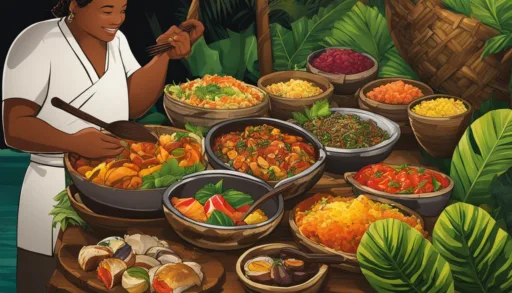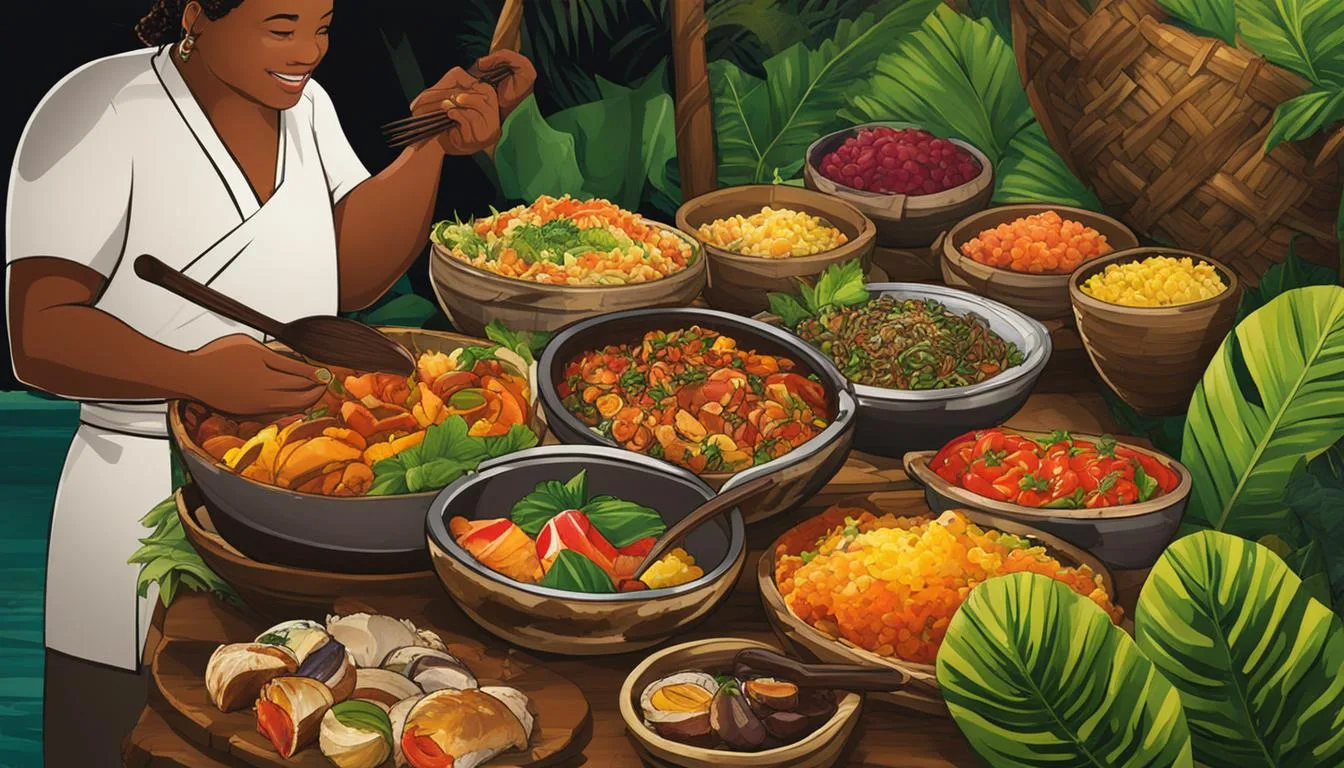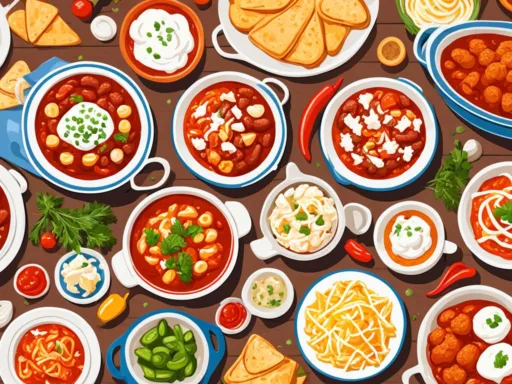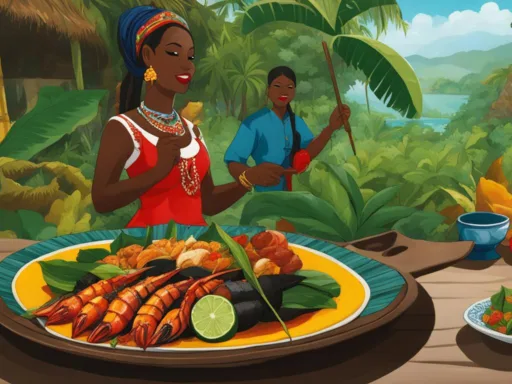It might come as a surprise to learn that Fiji, known for its stunning sapphire waters and lush landscapes, is home to a culinary scene that rivals its natural beauty. The Fijian culinary exploration is an unexpected odyssey of tropical flavors and textures, offering a palate as diverse as the archipelago’s cultural tapestry. With traditional Fijian dishes that are crafted with simplicity yet burst with flavor, to a Fijian gastronomy that infuses indigenous ingredients with global influence—Fiji’s food culture is an unsung hero amongst global cuisines. Through traditional cooking methods and a variety of local produce, the Fijian food culture is a testament to the island’s ability to offer dishes that are as rich and vibrant as its panoramic views.
Key Takeaways
- Embark on a Fijian culinary exploration to experience a blend of traditional Fijian dishes and global flavors.
- Learn about Fijian gastronomy, which combines fresh, local ingredients with a multicultural history.
- Embrace the communal aspect of Fijian food culture through time-honored cooking techniques.
- Delight in discovering the natural ingredients that elevate the unique tastes of Fiji’s cuisine.
- Fijian food culture reflects not just a meal, but an entire history and lifestyle on a plate.
- Understand why traditional Fijian dishes are not just food but an expression of the island’s soul.
The Unique Allure of Fijian Cuisine
The South Pacific archipelago of Fiji, renowned for its crystal-clear waters and soft, sandy beaches, also boasts a remarkable culinary tradition that is an essential part of its cultural identity. Fijian food exploration uncovers a delectable tapestry of taste, as each dish tells the story of the archipelago’s rich history and the melding of diverse culinary influences. Embarking on a journey through Fijian cooking traditions not only satisfies the palate but also offers insight into the spirit of the islands.
Combining Traditional and Multicultural Influences
The essence of Fijian cuisine lies in its ability to blend the old with the new, the native with the foreign, all while maintaining a distinctiveness that is unmistakably Fijian. History has seasoned Fiji’s gastronomic landscape with a blend of indigenous Melanesian food practices, the cunning culinary styles of European settlers, the fragrant spices brought by Indian laborers, and the unique flavors introduced by Chinese migrants. This cultural medley has culminated in traditional Fijian dishes deeply enriched by a world of diverse culinary influences.
The Healthy Staples of Fijian Diets
Fijians have long thrived on the earth’s natural bounty, favoring a diet firmly grounded in the produce of their fertile lands and teeming waters. Staples such as taro and cassava are the cornerstones of Fijian diets, their starchy goodness providing sustained energy and vital nutrients. The opulence of the Pacific Ocean gifts Fijian tables with an array of seafood from colorful reef fish to succulent shellfish—each contributing heart-healthy proteins and omega-3 fatty acids to this wholesome and flavorful diet.
Natural Cooking Methods: A Flavorful and Healthy Approach
Natural cooking methods have been honed over generations, perfectly adapted to enhance the flavors of the local fare. Traditional techniques such as the ‘lovo’, an underground oven, impart a smoky tenderness to meats and root vegetables alike, forming the centerpiece of communal feasts and celebrations. Obviating the need for added fats and oils, these methods not only intensify the taste of traditional Fijian dishes but also preserve their nutritional integrity, ensuring that each meal is as healthful as it is hearty.
Through our exploration of Fijian culinary delights, we discover a world where food serves as both sustenance and symbol, a reflection of the islands’ history and their embrace of the world’s diverse cultures. The seductive allure of Fijian cuisine beckons to all who seek a taste that is at once comforting and exotic, straightforward yet sophisticated—a gastronomic paradox that is uniquely and enchantingly Fijian.
Feast for the Senses: The Essential Dishes of Fiji
Embarking upon Fijian culinary experiences is akin to a sensory journey wrought with vibrant colors, diverse textures, and a symphony of flavors. To truly understand the food and flavors of Fiji, one must delve into the array of traditional Fijian dishes, each offering a glimpse into the island’s rich cultural heritage.
The delectable journey begins with Kokoda, the Fijian take on ceviche. Unlike its Latin American counterparts, this dish is steeped in local tradition, where fresh fish is cured in citrus juice and bathed in coconut milk, resulting in a dish that is light, refreshing, and unapologetically Fijian.
For those who favor richer, more robust flavors, Fish Suruwa, a tantalizing curry, exhibits the fusion of Fijian and Indian palates. This dish features local seafood simmered in a fragrant fusion of spices, a clear nod to Fiji’s multicultural influences.
As we delve deeper into the heart of Fijian cuisine, the encounter with Palusami is inevitable. Delicate taro leaves harbor a filling of succulent meat and coconut cream, slow-cooked to melt-in-your-mouth perfection. Palusami is more than food; it’s a cultural immersion.
Each Fijian specialty not only satisfies the appetite but also tells a story of the islands’ past, from indigenous traditions to the dynamism brought about by global influences.
Fijian food and flavors come full circle with Lovo—not merely a cooking technique but a centerpiece for communal feasting. Lovo involves slow-cooking food in an earth oven, infusing it with smoky, earthy nuances that epitomize the essence of Fijian cooking. To experience a Lovo is to partake in a ritual that celebrates togetherness and bounty.
Let’s explore a table that vividly presents some of Fiji’s culinary treasures:
| Dish | Key Ingredients | Flavors and Textures | Cultural Significance |
|---|---|---|---|
| Kokoda | Fish, citrus, coconut milk | Refreshing, tangy, creamy | Fijian adaptation of ceviche, a fusion of native and Latin American techniques |
| Fish Suruwa | Seafood, curry spices, coconut milk | Rich, spicy, aromatic | Reflection of Indian influence, a symphony of local produce and vibrant spices |
| Palusami | Taro leaves, meat, coconut cream | Savory, tender, velvety | Indigenous roots, a taste of traditional Fijian family gatherings |
| Lovo | Various meats and vegetables | Smoky, earthy, succulent | Core to social and ceremonial events, a communal dining experience |
In summary, the rich tapestry of Fijian cuisine is much like its archipelago—not one island but a collection of many, each offering a distinctive taste and experience. For the epicurean adventurer, these dishes are not just about sustenance but a voyage through Fiji’s storied past, its vibrant present, and an inviting glance into its future.
A Gastronomic Adventure with Traditional Fijian Dishes
Embark on a culinary journey through the heart of the Pacific and delve into the rich tapestry of traditional Fijian dishes. As we explore the hallmark flavors and practices of Fijian food culture, each meal narrates a story of the islands’ lush environment and the community spirit that thrives within it.
Kokoda: Fiji’s Signature Seafood Delight
Revered as one of the crown jewels of Fijian cuisine, Kokoda captivates the senses with its zestful combination of citrus-marinated raw fish lavished in creamy coconut milk. This delicacy not only shares similarities with other Polynesian seafood classics, but it also carries a distinctive Fijian character that sets it apart— a perfect symphony of taste that reflects the essence of Fiji’s ocean blessings.
Palusami: Wrapped Taro Leaves with a Flavorful Filling
Comfort food takes a delectable turn in the form of Palusami, a heartwarming dish made from taro leaves, meticulously wrapped and filled with delectable meat and succulent coconut milk. A Fijian celebration of flavors, these bundles are traditionally nestled into a Lovo, the earthen oven, infusing them with a unique, smoky savor that can only be described as authentically Fijian.
Lovo: The Fijian Barbecue Tradition
The Lovo stands as a testament to Fiji’s communal and vibrant food culture—a traditional method of cooking reminiscent of an earthen barbecue. Within its subterranean embrace, meats, seafood, and vegetables are slow-cooked to unparalleled tenderness, imbibed with a delicate smokiness that symbolizes a sacred bond between land and community. A traditional lovo feast is not merely a meal but a social event, a celebration of unity and the very spirit of Fiji itself.
The Impact of Indian Culture on Fijian Food
The aromatic tapestry of Fijian cuisine is richly woven with the threads of Indian culinary influences, a testament to the deep-rooted cultural exchange that has seasoned the islands’ gastronomic narrative. As a striking aspect of Fijian-Indo fusion, the robust spices and textured approach of Indian cookery have become a staple, lending an exotic complexity to the overall palate of Fiji.
Iconic to this culinary marriage are Fijian curries, which integrate the subcontinent’s vibrant palette of spices—such as turmeric, cumin, coriander, and garam masala—with local produce to create dishes that are at once comforting and uniquely Fijian. These curries often feature succulent seafood or tender meat simmered in rich coconut milk, embodying a harmonious blend of both cultures.
By infusing Fijian dishes with the essence of Indian spices, these flavors have become a distinctive feature of traditional Fijian fare, reflecting a shared history that has simmered over generations to present-day culinary delights.
Within the realm of this flavorful fusion, dishes like Fish Suruwa stand out. This particular curry utilizes fresh Fijian catches, illustrating how local ingredients can be adeptly adapted to Indian-inspired recipes, resulting in an unparalleled dining experience.
- Fijian Ingredients: Utilizing fresh, local produce and seafood.
- Indian Spices: Integrating spices like cumin and garam masala for profound depth of flavor.
- Cooking Techniques: Merging Indian slow-cooked methods with Fijian culinary customs.
Amidst the savory array of spices and textures, the influence of India on Fijian food transcends mere ingredients; it is a cultural embrace that has fortified the islands’ culinary identity, making it brilliantly distinct.
| Fijian-Indo Fusion Dish | Main Ingredients | Spices Used |
|---|---|---|
| Fish Suruwa (Curry) | Fresh fish, coconut milk | Cumin, turmeric, chili |
| Duruka Curry | Duruka (Fijian asparagus), coconut milk | Garam masala, mustard seeds |
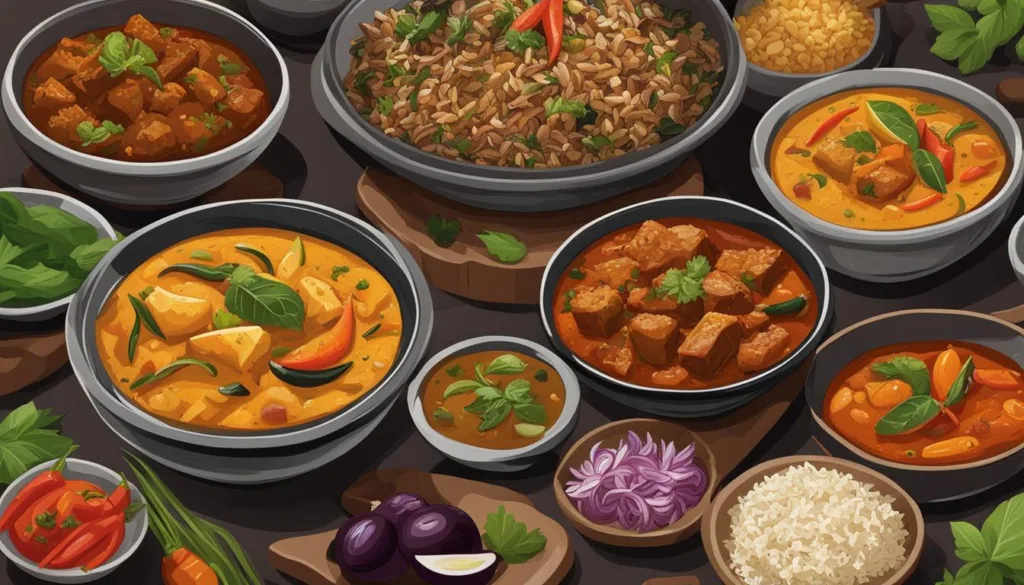
Fijian Culinary Exploration: The Best Dining Spots for Authentic Flavors
For anyone seeking the ultimate Fijian culinary experiences, the quest for authentic flavors takes you from the opulence of resort dining to the vibrant street food scene. Fiji’s gastronomy is as diverse as its stunning landscape, with each venue offering a glimpse into the rich tapestry of local and traditional Fijian dishes.
Resort Dining: A Blend of Luxury and Local Cuisine
The search for the best Fijian restaurants may lead you to luxurious resorts where the harmony of high-end ambiance and Fijian gustatory traditions await. Resorts such as Six Senses and Yasawa Island Resort & Spa, renowned for their beautiful vistas, match that beauty on the plate with an array of traditional Fijian dishes crafted from the freshest local ingredients.
Street Food Excursions: Tasting Fiji’s Culinary Diversity
For those looking to dive deeper into Fijian gastronomy, the streets beckon with robust flavors. Here, the essence of Fiji’s culinary diversity is captured in the sizzle of street grills and the aromatic curries that permeate the air. Every bite offers insight into the way Fijians combine land and sea to create a vibrant food scene.
| Resort/Location | Signature Dish | Dining Experience |
|---|---|---|
| Six Senses Fiji | Kokoda | Upscale beachfront dining with a focus on sustainability and local produce |
| Yasawa Island Resort & Spa | Lovo-prepared specialties | Intimate dining with views of the white sand shores and clear blue waters |
| Likuliku Lagoon Resort | Palusami | Over-water bungalow setting that offers an authentic Fijian dining aesthetic |
| Street Food Markets | Curry and Roti combinations | Lively ambiance with true local flavors found in bustling open-air markets |
As you explore the islands, the intertwining of Fijian culinary heritage with innovative cooking will surely captivate your palate, offering a memorable journey through one of the world’s most enticing gastronomic landscapes.
Fijian Gastronomy: A Closer Look at Fiji’s Food Staples
The islands of Fiji are not only a haven for breathtaking scenery but also for gastronomic delight. At the heart of Fijian cuisine are the humble yet versatile Fijian food staples – the root vegetables and fresh seafood that form the foundation of traditional Fijian cooking.
Root Vegetables – The Hearty Base of Many Meals
Starchy and nourishing, root vegetables have been central to the Fijian diet for centuries. Taro, with its mild, nutty flavor, cassava – also known as manioc – and the sweet, earthy tones of sweet potatoes, provide the necessary energy and are used in a myriad of ways across the islands. These root vegetables are not merely sustenance; they carry a cultural significance that resonates through Fijian society.
Seafood – A Fresh Bounty from the Pacific
Fresh seafood is the jewel of the Pacific and a significant component of Fijian cuisine. From the vibrant, firm flesh of mahi-mahi to the succulent sweetness of tuna and the luxurious texture of lobster, the ocean provides an abundant and varied offering. The traditional methods of preparation respect the pristine quality of these ingredients, allowing their natural essence to shine through.
| Root Vegetable | Description | Common Dishes |
|---|---|---|
| Taro | Starchy root with a nut-like flavor | Lovo, Taro chips, Palusami |
| Cassava | Root with a texture like potato | Cassava cake, Boiled cassava with coconut milk |
| Sweet Potato | Naturally sweet root vegetable | Sweet potato fries, Sweet potato in coconut milk |
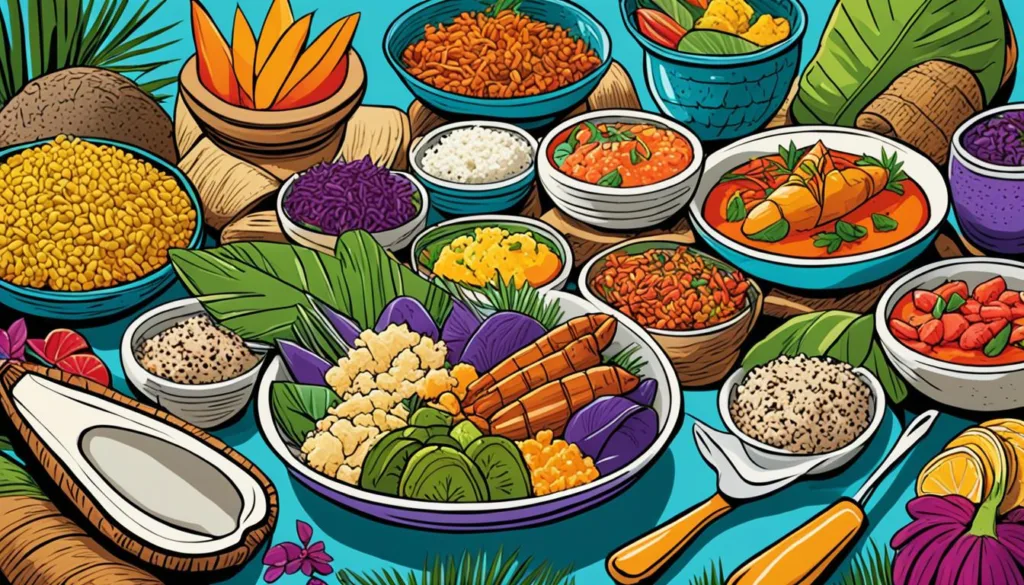
The act of enjoying these staples goes beyond mere consumption; it is a dive into the vibrant culture and the rich history etched into the very soil of Fiji. Whether it be through a feast cooked in a lovo pit or a simple dish highlighting the earthy notes of the root vegetables and the fresh flavors of the sea, every bite is a testament to the islands’ natural bounty.
Uncovering the Fusion of International Flavors in Fijian Cuisine
The Fijian culinary exploration is akin to a vibrant tapestry, richly woven with threads of international culinary influences from across the globe. Each dish tells a story of its own, revealing the depth of Fijian gastronomy and its ability to adapt and innovate, creating an ever-evolving palette of fusion flavors that surprise and delight food enthusiasts and connoisseurs alike.
Fijian cuisine is not just a reflection of the island’s bountiful resources but also a homage to the various cultures that have come together on this archipelago. European, Indian, and Chinese settlers have seamlessly intertwined their culinary heritage with Fijian traditions, resulting in an extraordinary and eclectic food scene that stands out as a dynamic form of cultural expression.
- Tapping into the earthly sweetness of taro, a staple in Fijian diets, chefs have artistically combined it with robust Indian spices, allowing a dance of textures and tastes in every bite.
- The use of coconut, both as a base in beverages and curries, exemplifies the island’s tropical essence, blending smoothly with fusion flavors from Indian and Asian cuisines.
- A surge of Chinese elements, seen in the frequent use of soy and oyster sauces, adds yet another layer of depth to the culinary canvas of Fiji.
Let us closely examine how international tastes have melded with local Fijian offerings:
| Ingredient | Fijian Use | International Influence | Fusion Outcome |
|---|---|---|---|
| Taro | Root-based dishes | Indian curries and spices | Spiced Taro Curry |
| Coconut Milk | Kokoda (Fijian ceviche) | Asian flavors in soups and broths | Coconut-infused Broth with Seafood |
| Seafood | Fresh, grilled, or in Lovo pit | Chinese stir-fry technique | Wok-Tossed Seafood with Pacific Greens |
The culinary mesh that unfolds within Fiji’s food scene exemplifies how cultures can come together harmoniously, crafting new experiences that captivate both the local community and guests from afar. Thus, the entwining of international culinary influences into the fiber of Fijian meals is not merely about taste—it’s also a powerful narrative of cultural fusion and gastronomic innovation.
The Significance of Traditional Cooking Methods in Fijian Gastronomy
In the heart of the South Pacific, traditional cooking methods play a vital role in the preservation of Fijian culinary traditions. Among these, the lovo pit stands as a testament to the country’s rich heritage. In this article, we delve into the significance of these time-honored cooking techniques, particularly the lovo pit and the use of banana leaves, which are fundamental in bringing Fijian cuisine to life.
The Lovo Pit: An Oven Beneath the Earth
The lovo pit is more than a cooking apparatus; it is a cultural icon deeply ingrained in the Fijian way of life. This traditional method involves digging a hole in the ground, heating stones in a fire, and then placing marinated foods wrapped in banana leaves atop the hot stones. Earth is then used to cover everything, creating an oven that steams and smokes the food to succulent perfection.
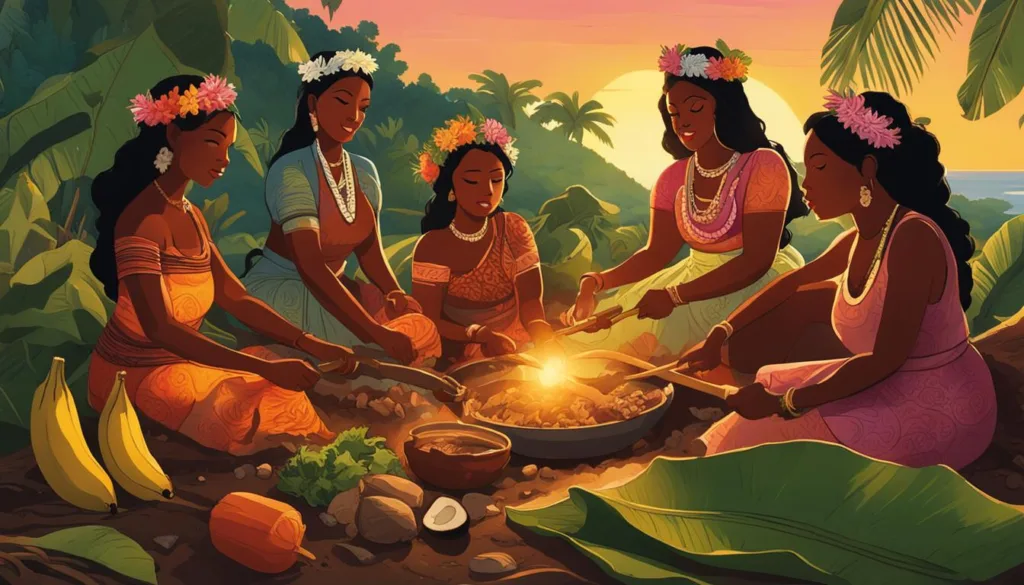
Meals prepared in a lovo pit are a highlight at grand celebrations, bringing communities together to enjoy a feast that is rich in both flavor and tradition.
The Use of Banana Leaves in Enhancing Flavor
An important complement to the lovo pit is the use of banana leaves. When wrapped around food before it’s placed in the lovo, these leaves impart a subtly sweet and smoky note to the dish, a flavor that is distinctive and irreplaceable in Fijian culinary traditions. This method transcends purely culinary purposes, symbolizing the respect for natural resources and ancestral wisdom.
Advancing the Fijian gastronomic narrative, let’s compare these traditional techniques, highlighting why these methods are crucial to the authentic flavors celebrated in Fiji’s cuisine.
| Cooking Technique | Description | Cultural Significance | Typical Dishes |
|---|---|---|---|
| Lovo Pit | Earthen oven using hot stones where food is slow-cooked beneath the ground | Centers on communal gatherings and feasts | Lovo-prepared pork, fish, taro, and sweet potatoes |
| Banana Leaves | Leaves used to wrap food, infusing it with flavor during cooking | Reflects the sustainable use of natural materials and respect for the environment | Palusami (taro leaves with coconut milk and meat or fish) |
By maintaining and cherishing these traditional methods such as the lovo pit and cooking with banana leaves, Fijians ensure the survival and appreciation of flavors that are uniquely their own, providing an authentic taste of the islands’ soulful culinary offerings.
The Role of Exotic Fruits in Fijian Cuisine
The tapestry of Fijian cuisine is richly woven with vibrant flavors and an abundance of exotic fruits that epitomize the tropical allure of the islands. These fruits not only tantalize the tastebuds as standalone treats but are also pivotal in creating a cascade of fruit-forward dishes that reflect the vibrant spirit of Fiji. With each slice and dice, these fruits contribute significant aesthetic appeal and bursts of refreshing taste to the gastronomic narrative of this Pacific paradise.
Fiji’s Lush Fruit – Adding Sweetness and Vibrancy
Indigenous fruits such as papaya, banana, pineapple, and jackfruit are cornerstone ingredients that infuse natural sweetness into the local food scene. Whether served as a dessert, used in breakfast dishes, or incorporated into savory meals, these fruits are essential to presenting a genuine Fijian feast that is both visually and palate pleasing.
Curating Fruit-Forward Dishes and Drinks
Fijian chefs and home cooks alike take pride in preparing fruit-forward dishes that highlight the islands’ bountiful harvests. The versatility of Fiji’s fruits extends to the bar scene where bartenders concoct colorful drinks that are emblematic of the island’s festive essence. Here’s a glimpse into some of the exotic combinations you might encounter in Fijian cuisine.
| Exotic Fruit | Dish or Drink | Flavor Profile |
|---|---|---|
| Papaya | Papaya Salad | Sweet and tangy with a hint of chili |
| Banana | Banana in Coconut Milk | Creamy and sweet with a rich coconut aroma |
| Pineapple | Grilled Pineapple Skewers | Charred sweetness with a smoky edge |
| Jackfruit | Jackfruit Curry | Savory and meaty with tropical freshness |
Exotic fruits are not merely add-ons or garnishes in Fijian cuisine; they are the soul of the culinary landscape, bringing to life dishes and drinks that speak resoundingly of Fiji’s tropical identity. Their role goes beyond taste, as they forge a connection between the island’s rich agricultural heritage and the modern aspirations of Fijian chefs to innovate while staying rooted in tradition.
Fijian Hospitality: A Key Ingredient in Culinary Experiences
When exploring the rich tapestry of Fijian culture, the unparalleled warm hospitality of its people fundamentally enhances the culinary experiences of any visitor. The manner in which Fijians welcome guests to their table is as rich and flavorful as the food served, making Fijian hospitality an essential ingredient to the nation’s cuisine.
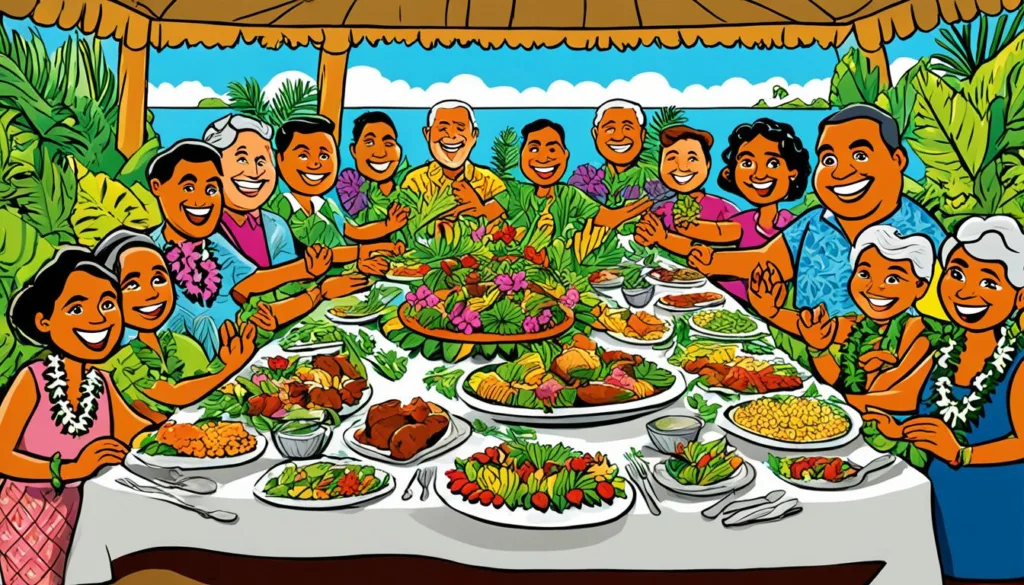
Every dish served in Fiji is more than just a meal; it’s a communal offering that symbolizes a bond between host and guest, a shared delight in the vibrant diversity of flavors that Fijian gastronomy has to offer. From the markets brimming with fresh produce to the resorts with chefs dedicated to showcasing local cuisine, the kindness and sincerity that underpin Fijian hospitality are always present.
Embodying the spirit of ‘Bula’, which translates to ‘life’ but encompasses so much more, Fijian hospitality invites guests to not only taste but become part of the island’s life and family.
In the spirit of genuine connection, here’s a snapshot of how Fijian hospitality deeply influences the dining experience:
| Element of Hospitality | Impact on Culinary Experience |
|---|---|
| Personal Greetings | Creates an intimate and welcoming atmosphere |
| Serving Traditional Dishes | Offers a taste of Fijian heritage and tradition |
| Sharing Stories | Enriches the meal with cultural and historical context |
| Attention to Guest Preferences | Shows a deep care for guest satisfaction and comfort |
| Invitation to Participate | Engages guests in the food preparation and ceremony |
At its heart, the warm embrace of Fijian hospitality reaches beyond the borders of their lush islands, promising visitors not just a meal, but a memory that weaves together the pleasure of culinary art with human connection. Truly, the essence of Fijian hospitality is about making everyone feel like family, and there is no better place to feel that kinship than around a table, sharing the island’s bounty.
Seafood Specialties: From Fiji’s Ocean Waters to the Table
Immerse yourself in the succulent world of Fijian seafood specialties where the native seafood dishes exemplify the pure ocean-to-table experience. The rich marine life surrounding Fiji’s shores is not only a source of sustenance for locals but also a canvas for culinary artistry. Prepare to savor every bite infused with a genuine Fijian twist.
Discovering Fiji’s Native Seafood Dishes
Native to the crystal-clear waters of Fiji, revered dishes gracing the tables include delicacies like grilled mahi-mahi, prepared simply to let the freshness shine through. The ocean’s bounty offers an array of choices for those looking to delve into the heart of Fijian cuisine.
- Grilled Mahi-Mahi
- Sea Urchin (Cawaki)
- Crab in Coconut Broth
- Charred Octopus with Root Crop Puree
Experiencing Seafood with a Fijian Twist
The Fijian culinary landscape is a testament to the island’s ability to blend local flavors with international influences, creating a mosaic like no other. Fish Suruwa, a classic Fijian curry, incorporates local spices into traditional Indian curry, providing a unique take on seafood that is to be celebrated.
| Seafood Dish | Description | Fijian Twist |
|---|---|---|
| Fish Suruwa (Fijian Fish Curry) | A stunning medley of local fish simmered in a rich coconut curry sauce. | The addition of Fijian spices and ingredients like breadfruit elevates the traditional curry to new heights. |
| Barbecued Lobster | Freshly caught lobsters grilled to perfection, often over an open flame. | Served with a side of green papaya salad, lending a refreshing contrast to the savory lobster. |
| Kokoda | Fiji’s answer to ceviche, fresh raw fish cured in lemon juice and coconut milk. | A balance of tangy and creamy notes, often accompanied by finely chopped chillies and vegetables. |
| Clam and Taro Soup | A hearty soup highlighting succulent clams and earthy taro. | Infused with aromatic herbs and spices grown on the islands, this soup warms the soul with Fijian comfort. |
Whether you’re dining in a lavish resort or enjoying the catch of the day by the seaside, Fijian seafood dishes tell a story of tradition, culture, and the siren call of the ocean. Relish in these culinary creations and experience the true essence of Fiji’s ocean-to-table philosophy.
Conclusion
Embarking on a Fijian culinary journey unveils a tapestry of flavors that narrate the story of an island nation rich in history and multisensory experiences. Amidst the tropical splendor of Fiji, the culinary landscape tells a tale of traditional Fijian cuisine passed down through generations, harmoniously mingling with the zestful influences of Indian and Chinese migrants. The result is an exquisite gastronomic discovery that goes beyond mere eating—it’s a foray into the very soul of Fijian culture, characterized by its use of fresh local produce, aromatic spices, and time-honored cooking traditions.
From the smoky, succulent offerings of a traditional lovo feast to the citrus-infused delights of Kokoda, every dish serves as a testament to the nation’s culinary prowess. Intricate flavors weave through each recipe, revealing the narrative of an archipelago where community, land, and sea converge on the palate. This is a place where food is more than sustenance; it is an expression of identity and camaraderie, shared over tales of yesteryears and today’s fellowship.
In essence, each meal within Fiji’s borders is an invitation to savor and appreciate a cuisine that captures the warmth of its people and the richness of its heritage. Whether it’s through the tender embrace of a freshly wrapped palusami or the comforting embrace of a spiced curry, there’s an indelible mark left on those who dine here, etching memories of a place where every dish extends a hospitable hand and nourishes the wanderlust spirit.
